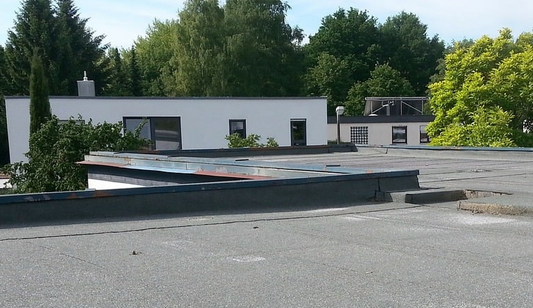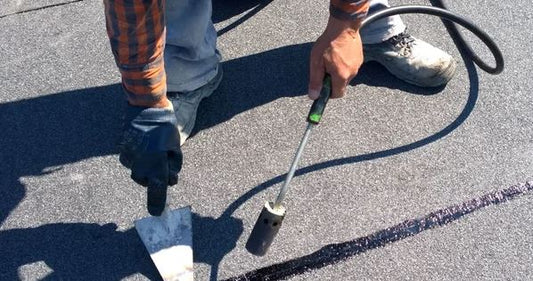You'll need to act quickly when you spot a puncture in your PVC single-ply roof, as even small holes can lead to significant water damage. While these durable membranes can withstand typical weathering, they're not immune to sharp debris, maintenance equipment, or heavy foot traffic. Understanding the proper repair techniques and knowing when to call professionals can save you thousands in potential structural repairs and protect your building's integrity.
Key Points
- Inspect PVC roofs regularly for water stains, visible holes, and pooling water to identify punctures before they cause significant damage.
- Use manufacturer-approved PVC membrane patches and a heat welder for permanent repairs to maintain warranty compliance.
- Clean the damaged area thoroughly with PVC cleaner and ensure the surface is dry before attempting repairs.
- Apply temporary patches for emergency repairs during adverse conditions, but schedule permanent fixes within 3-6 months.
- Follow safety protocols including non-slip footwear and fall protection when accessing the roof for inspection or repairs.
Common Causes of PVC Roof Punctures
While PVC roofing is known for its durability, several factors can lead to punctures and compromised performance.
You'll often find damage from falling branches, especially during storms or if trees hang over your roof. Foot traffic from maintenance workers can also cause tears, particularly when they're carrying heavy tools or equipment.
Sharp debris like rocks or metal pieces that get blown onto your roof pose another significant risk. HVAC technicians and other contractors who service rooftop units sometimes drop tools or drag equipment across the membrane.
In colder climates, ice formation and repeated freeze-thaw cycles can make the PVC material more susceptible to punctures. Additionally, you need to watch for damage from animal activity, especially birds and rodents that might scratch or gnaw at the roofing material.

Signs and Symptoms of Roof Damage
The most telling signs of PVC roof damage often reveal themselves through indoor symptoms first.
You'll notice water stains on your ceiling, drips during rainstorms, or musty odours that indicate moisture infiltration. If you see bubbling or peeling paint on your walls, that's another red flag.
On the roof itself, you'll want to look for visible holes, tears, or punctures in the PVC membrane.
Watch for pooling water, which can indicate low spots or improper drainage. You might also spot membrane separations at the seams, wrinkles in the material, or areas where the membrane has pulled away from walls or flashings.
Discoloration, brittleness, or cracking of the PVC material suggests aging or chemical damage that needs immediate attention.
Essential Tools and Materials for Repairs
Successful PVC roof repairs start with having the right tools and materials on hand.
You'll need a heat welder, seam probe, wire brush, cleaning solvent, clean rags, scissors, chalk line, measuring tape, and safety equipment including gloves and eye protection.
For the actual repairs, gather PVC membrane patches that match your roof's material and thickness, PVC cleaner, and compatible sealant.
Keep additional items like a sturdy ladder, utility knife with spare blades, and a metal roller nearby.
If you're working with larger tears, you might also need reinforcement plates and fasteners.
Don't forget to stock essential safety items like roof markers, warning flags, and non-slip shoes.
Store these materials in a waterproof container that's easily accessible when roof problems occur.

Safety Precautions Before Starting Work
Before beginning any PVC roof repair work, you must establish proper safety protocols to protect yourself and others on the job site.
Always wear non-slip footwear, safety glasses, and cut-resistant gloves. Don't work on wet or icy surfaces, and check weather conditions before starting.
Set up proper fall protection equipment if you're working at heights, including guard rails or a personal fall arrest system.
Keep your work area clear of unnecessary tools and debris that could cause tripping hazards.
You'll need to guarantee adequate lighting and ventilation, especially when using adhesives or cleaners.
If you're using electrical tools, inspect all cords and keep them away from standing water.
It's also vital to identify and avoid stepping on any weak spots or skylights in the roof structure.
Step-by-Step PVC Membrane Repair Process
Repairing PVC membrane roofs involves six essential steps that you'll need to follow carefully. The process requires attention to detail and proper execution to guarantee a lasting repair.
| Step | Action | Tools Needed |
|---|---|---|
| 1 | Clean the damaged area | Scrub brush, cleaner |
| 2 | Mark repair boundaries | Marker, measuring tape |
| 3 | Cut round patch | Scissors, patch material |
| 4 | Apply PVC adhesive | Brush, bonding adhesive |
| 5 | Position patch | Roller, heat gun |
| 6 | Heat weld edges | Welding tool |
Once you've gathered your materials, start by thoroughly cleaning the damaged section. Cut your patch to extend 2 inches beyond the damage in all directions. Apply adhesive evenly to both surfaces, allowing proper tack time. Position your patch carefully and roll from centre outward to remove air bubbles. Finally, heat weld all edges to create a watertight seal.
Temporary vs. Permanent Repair Solutions
When facing a PVC roof leak, you'll need to decide between temporary and permanent repair solutions based on several factors, including weather conditions, repair urgency, and available resources.
Temporary fixes like emergency patches or sealants can quickly stop water infiltration during adverse weather, but they typically last only 3-6 months. You'll want to use these when immediate action is necessary and proper repairs aren't feasible.
Permanent solutions involve professional heat welding of PVC patches or complete membrane replacement. While they require more time, expertise, and investment, they'll restore your roof's integrity for years to come.
If you opt for a temporary fix, make sure to schedule a permanent repair within the temporary solution's lifespan to prevent further damage and additional costs.
Preventing Future Punctures and Damage
To maintain your PVC roof's longevity and prevent future damage, you'll need to implement several protective measures and maintenance practices. Regular inspections, removing debris, and installing protective walkways can greatly reduce puncture risks.
| Preventive Measure | Key Benefit |
|---|---|
| Install walkway pads | Protects high-traffic areas from wear and tear |
| Trim overhanging branches | Prevents falling limbs and leaf accumulation |
| Add roof screens | Blocks debris from HVAC and exhaust systems |
Don't let maintenance workers drag equipment across your roof. Instead, make sure they use proper lifting techniques and designated paths. You should also maintain your drainage system to prevent standing water, which can weaken the membrane over time. Consider installing additional protection around rooftop units and other penetrations where service work frequently occurs.
When to Call Professional Roofers
Professional roofers should handle any PVC roof repairs that exceed simple patch jobs or require specialised equipment.
When you notice extensive damage, multiple punctures, or signs of ageing that affect large sections of your roof, it's time to contact an expert.
Call a professional roofer when you encounter:
- Tears or holes larger than 6 inches in diameter
- Damage near seams, flashings, or roof penetrations
- Water infiltration that's difficult to trace
- Signs of membrane separation or delamination
You'll also need professional help if you lack proper safety equipment or if local building codes require licensed contractors for roof repairs.
Don't attempt repairs during severe weather conditions or if you're unsure about the extent of the damage.
Professional roofers have the tools, expertise, and safety equipment to properly assess and fix complex roofing issues.
Maintenance Tips for Extended Roof Life
While professional repairs are essential for major issues, regular maintenance can prevent many PVC roofing problems from developing in the first place.
You'll need to inspect your roof at least twice a year and after severe storms. Remove debris, leaves, and branches promptly to prevent membrane damage and water pooling.
Keep your gutters and drains clear to guarantee proper water drainage. Check all seams, flashings, and termination points for signs of separation or wear.
You should also examine the membrane for punctures, tears, or areas of deterioration. If you spot small issues, document them and monitor their progression.
Don't let tree branches hang over your roof, as they can cause scratches and punctures.
When walking on the roof, use protective footwear and follow designated walkways to minimise wear on the membrane.
Warranty Considerations for Repairs
Before undertaking any repairs on your PVC roof, you'll need to review your warranty documentation carefully.
Many manufacturers have strict requirements about who can perform repairs and what materials they'll allow. Unauthorised repairs might void your warranty completely.
Your warranty coverage typically depends on several key factors:
- The age of your PVC roof and the remaining warranty period
- Whether you've maintained proper documentation of regular inspections
- If you're using manufacturer-approved materials and methods
- Whether a certified contractor is performing the repair work
Contact your warranty provider before proceeding with any repairs. They'll often want to inspect the damage first and may require you to use their approved contractors.
Remember that some minor repairs might fall under normal maintenance, which isn't usually covered by standard warranties.
Rounding Up
While you can handle minor PVC roof repairs yourself, it's essential to follow proper procedures and safety protocols. Remember to inspect your roof regularly, address damage promptly, and maintain documentation for warranty purposes. If you're unsure about the repair's complexity or don't have the right tools, don't hesitate to call a certified professional. With proper care and maintenance, your PVC roof will protect your building for years to come.




